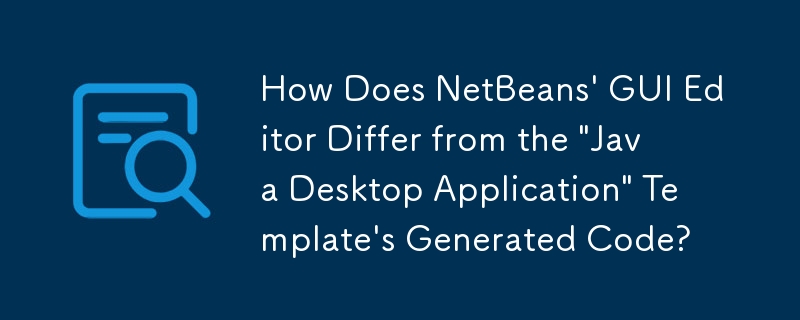 Java
Java
 javaTutorial
javaTutorial
 How Does NetBeans' GUI Editor Differ from the 'Java Desktop Application' Template's Generated Code?
How Does NetBeans' GUI Editor Differ from the 'Java Desktop Application' Template's Generated Code?
How Does NetBeans' GUI Editor Differ from the 'Java Desktop Application' Template's Generated Code?
Dec 18, 2024 am 01:42 AM
Netbeans GUI Editor: Deciphering the Enigmatic Code
When embarking on a Java application development journey in Netbeans, one may encounter a perplexing issue: the enigmatic code generated when selecting the "Java Desktop Application" template. This code, featuring unfamiliar packages like "org.jdesktop.application.SingleFrameApplication" and a peculiar main() declaration, deviates significantly from the familiar Swing framework.
Delving into the Enigma:
This code generation arises from inadvertently selecting the "Java Desktop Application" template, intended for creating applications within the Swing Application Framework (JSR 296). This framework streamlines the development process by providing pre-built infrastructure like menus, status bars, and window state persistence.
The org.jdesktop.application.SingleFrameApplication class forms the cornerstone of this framework, providing the application's infrastructure, including event handling, window management, and resource access. The main() method, launched using the launch method, initializes the application.
Bringing Forth the GUI Editor:
To utilize the GUI editor, an indispensable tool for visual application design, when creating a Java application from scratch, embark on the following steps:
- Navigate to File > New File > Java GUI Forms.
- Choose a container, such as JPanel, toinstantiate from the main() method.
- Design the GUI components using the GUI editor.
Understanding the Generated Code:
The code generated by the GUI editor encapsulates the visual components and their properties. It adheres to a特定的 convencion:
- "Generated Code" comments delineate automatically generated code.
- Components are declared using the corresponding javax.swing.* classes.
- Event handling logic is implemented within the initComponents() method.
A Stroll Through an Example:
Main.main():
public static void main(String[] args) {
EventQueue.invokeLater(new Runnable() {
@Override
public void run() {
JFrame f = new JFrame();
f.setDefaultCloseOperation(JFrame.EXIT_ON_CLOSE);
f.add(new NewJPanel());
f.pack();
f.setVisible(true);
}
});
}
NewJPanel built using the GUI editor:
public class NewJPanel extends javax.swing.JPanel {
// ...
@SuppressWarnings("unchecked")
// <editor-fold defaultstate="collapsed" desc="Generated Code">
private void initComponents() {
// ...
}
// </editor-fold>
// ...
}
Embracing the GUI Editor:
With the GUI editor now within reach, developers can seamlessly craft visually engaging and functional Java applications in Netbeans, eliminating the need to decipher enigmatic code.
The above is the detailed content of How Does NetBeans' GUI Editor Differ from the 'Java Desktop Application' Template's Generated Code?. For more information, please follow other related articles on the PHP Chinese website!

Hot AI Tools

Undress AI Tool
Undress images for free

Undresser.AI Undress
AI-powered app for creating realistic nude photos

AI Clothes Remover
Online AI tool for removing clothes from photos.

Clothoff.io
AI clothes remover

Video Face Swap
Swap faces in any video effortlessly with our completely free AI face swap tool!

Hot Article

Hot Tools

Notepad++7.3.1
Easy-to-use and free code editor

SublimeText3 Chinese version
Chinese version, very easy to use

Zend Studio 13.0.1
Powerful PHP integrated development environment

Dreamweaver CS6
Visual web development tools

SublimeText3 Mac version
God-level code editing software (SublimeText3)

Hot Topics
 Java Features for Modern Development: A Practical Overview
May 08, 2025 am 12:12 AM
Java Features for Modern Development: A Practical Overview
May 08, 2025 am 12:12 AM
Javastandsoutinmoderndevelopmentduetoitsrobustfeatureslikelambdaexpressions,streams,andenhancedconcurrencysupport.1)Lambdaexpressionssimplifyfunctionalprogramming,makingcodemoreconciseandreadable.2)Streamsenableefficientdataprocessingwithoperationsli
 Java Platform Independence: Advantages for web applications
May 09, 2025 am 12:08 AM
Java Platform Independence: Advantages for web applications
May 09, 2025 am 12:08 AM
Java'splatformindependencebenefitswebapplicationsbyallowingcodetorunonanysystemwithaJVM,simplifyingdeploymentandscaling.Itenables:1)easydeploymentacrossdifferentservers,2)seamlessscalingacrosscloudplatforms,and3)consistentdevelopmenttodeploymentproce
 Can Java be run everywhere?
May 07, 2025 pm 06:41 PM
Can Java be run everywhere?
May 07, 2025 pm 06:41 PM
Yes,Javacanruneverywhereduetoits"WriteOnce,RunAnywhere"philosophy.1)Javacodeiscompiledintoplatform-independentbytecode.2)TheJavaVirtualMachine(JVM)interpretsorcompilesthisbytecodeintomachine-specificinstructionsatruntime,allowingthesameJava
 The Truth About Java's Platform Independence: Is It Really That Simple?
May 09, 2025 am 12:10 AM
The Truth About Java's Platform Independence: Is It Really That Simple?
May 09, 2025 am 12:10 AM
Java'splatformindependenceisnotsimple;itinvolvescomplexities.1)JVMcompatibilitymustbeensuredacrossplatforms.2)Nativelibrariesandsystemcallsneedcarefulhandling.3)Dependenciesandlibrariesrequirecross-platformcompatibility.4)Performanceoptimizationacros
 What are the four categories of Java? Description of Java Basic Type System Classification
May 20, 2025 pm 08:27 PM
What are the four categories of Java? Description of Java Basic Type System Classification
May 20, 2025 pm 08:27 PM
Java's four basic type systems include integer types, floating point types, character types and boolean types. 1. Integer types (byte, short, int, long) are used to store numerical values ??without decimals. Choosing the appropriate type can optimize memory and performance. 2. Float type (float, double) is used for decimal values. Pay attention to accuracy issues. If necessary, BigDecimal is used. 3. Character type (char) is based on Unicode and is suitable for single characters, but String may be required in international applications. 4. Boolean types are used for true and false values, simplifying logical judgments and improving code readability.
 Java Platform Independence: What does it mean for developers?
May 08, 2025 am 12:27 AM
Java Platform Independence: What does it mean for developers?
May 08, 2025 am 12:27 AM
Java'splatformindependencemeansdeveloperscanwritecodeonceandrunitonanydevicewithoutrecompiling.ThisisachievedthroughtheJavaVirtualMachine(JVM),whichtranslatesbytecodeintomachine-specificinstructions,allowinguniversalcompatibilityacrossplatforms.Howev
 Java features: a quick guide
May 07, 2025 pm 05:17 PM
Java features: a quick guide
May 07, 2025 pm 05:17 PM
Key features of Java include: 1) object-oriented design, 2) platform independence, 3) garbage collection mechanism, 4) rich libraries and frameworks, 5) concurrency support, 6) exception handling, 7) continuous evolution. These features of Java make it a powerful tool for developing efficient and maintainable software.
 What is the difference between JDK and JVM?
May 07, 2025 pm 05:21 PM
What is the difference between JDK and JVM?
May 07, 2025 pm 05:21 PM
JDKincludestoolsfordevelopingandcompilingJavacode,whileJVMrunsthecompiledbytecode.1)JDKcontainsJRE,compiler,andutilities.2)JVMmanagesbytecodeexecutionandsupports"writeonce,runanywhere."3)UseJDKfordevelopmentandJREforrunningapplications.





